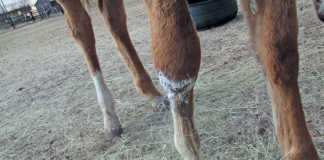
Photo: Bill Kerr
For example, many areas I visit are infected with beet cyst eelworm, and direct-sowing Swiss chard here can result in the plants being attacked when the young roots start growing.
This not only stunts the seedlings, but allows an extra generation of eelworm to breed.
You can argue that you have to fumigate or apply some other treatment in any case, but eelworm cannot be eliminated entirely, and the survivors end up attacking the crop for a longer period with direct sowing.
READ Improving tunnel production using even less water
Direct sowing also means that you have to pay more attention to creating a suitable seedbed, controlling weeds around delicate young seedlings, and generally taking extra care until the crop is well established.
On the other hand, the cost of direct sowing is much lower, as the seed is relatively cheap, whereas producing seedlings is expensive.
Farmers who carry out direct sowing sometimes plant a separate section and, when thinning this out, transplant these seedlings into the rest of the land.
If you do this, trim the leaves to reduce the leaf area; this will ensure that the remaining leaves all receive water from the damaged root system.
READ Spinach: a step-by-step guide on how to grow it
If you have experience, good seed and highly favourable conditions for emergence, you may not need to thin the plants out.
In this case, allow the extra plants to develop a little further, then pull them out, wash them, and sell them as ‘young spinach’, with the roots included.
Swiss chard ‘seed’ consists of a number of seeds in a corky structure so that several plants usually emerge from each ‘seed’. In some cases, these clusters are broken up into smaller pieces so that only one or two plants will emerge. This is not a problem.
A heavy feeder that needs good nutrition
Swiss chard is not fussy about soil type, but responds well to high organic levels. It does well in soils with a high salt concentration that may restrict other crops.
Because Swiss chard is a very heavy feeder and is usually in the land for an extended period, it requires good nutrition.
READ Niche farming: Organic seed production in the Sandveld
Crops that follow Swiss chard sometimes do not do as well as expected. There are three theories for this:
- Swiss chard may have allelopathic properties; in other words, it exudes biochemicals that inhibit the growth of another species following it;
- It extracts more nutrition from the soil and so deprives the following crop;
- It is susceptible to a number of eelworm species and, being in the soil for a long time, allows the population of these pests to build up and attack the following crop. I have often seen evidence of this.
Nitrogen and boron
Make sure the soil is well nourished before planting Swiss chard. Top up with nitrogen from time to time, guided by plant vigour and leaf colour.
As with beetroot, apply boron twice and three times as a foliar feed.
Bill Kerr is a vegetable specialist and breeder.











